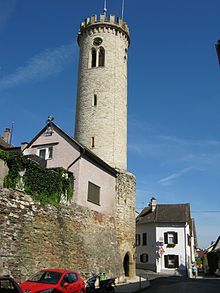Clock tower (Oppenheim)
The clock tower of Oppenheim in Rheinhessen in Rhineland-Palatinate is a stone clock tower built in 1843/44 in the neo-Gothic style , which is a good 31 meters high. The tower clock from 1907 shows the half and full hours with the chime .
history
The Oppenheim clock tower was built in 1843/44 on the remains of an earlier defense tower of the medieval city fortifications - the so-called customs tower or white tower . Over the decades, the tower not only had the task of providing information about the time of day. In the meantime, the tower also served as an observation point to warn of fires or floods , as a hose tower for the fire brigade and as an urban detention cell . The first clock built into the tower was replaced in 1907 by a new one from JF Weule in Bockenem in Ambergau , which still works.
In 1941 the tower bell was removed and melted down because there was a shortage of raw materials during World War II . In 1953 and 1989 two new bells were donated by the citizens of Oppenheim. In the 1980s, the clock tower was completely renovated. The building is maintained by the friends of the clock tower in Oppenheim am Rhein and is a listed building .
The tower clock shows the half and full hours with the help of a mechanical clockwork by striking a bell. In addition, the bell can be rung by hand, which among other things happens in memory of the war victims. In addition, a memorial book is displayed in the tower on the day of national mourning that contains the names of 254 citizens of Oppenheim who fell, killed and missing in World War II.
Customs Tower or White Tower
Today's clock tower stands on the remains of an earlier defense tower of the medieval city fortifications of Oppenheim - the so-called customs tower or White Tower . The name Zollturm can be traced back to the fact that it was located at the port and the city's customs house , where goods transported on the Rhine had to be cleared. The name White Tower is probably due to the light limestone or a white paint or plaster .
The tower was built in the 13th century and destroyed, rebuilt and rebuilt several times in the following centuries. The Gothic door arch of the entrance dates from the second half of the 14th century . After Oppenheim was already badly affected by the Thirty Years' War (1618–1648), the entire city including the customs tower was destroyed on May 31, 1689 in the Palatinate War of Succession by French troops under Ezéchiel de Mélac .
It was not until more than 150 years later that today's clock tower was built on the remains of the customs tower in 1843/44.
Appearance
The clock tower of Oppenheim is built on a round floor plan and is also completely designed as a round tower . He is (without spire and lace) over 31 meters high and consists of three parts: basement , tower body and viewing platform . Light limestone from the region was mainly used as building material.
The approximately twelve meter high basement of the tower with the entrance is the oldest part of the building and partly dates from the 13th century. It has a diameter of almost five meters and consists mainly of rough quarry stone masonry . In contrast, the Gothic door arch of the entrance on the east side of the tower dates from the second half of the 14th century and is made of darker, partly red sandstone.
The actual tower, around 18 meters high, rises above the basement and is in the neo-Gothic style. The tower body is set back a little compared to the basement and therefore does not make the tower appear so bulky despite the massive base. The limestone masonry is lighter here than in the basement, and the bricks are smaller and more evenly layered.
The tower body is loosened up in all four directions through different openings. In the lower third there is a loop-slit-like opening (key notch) on all four sides of the tower and in the middle third there is a small window with a pointed arch . In the upper third, on all four sides, there are two larger, lancet-arch windows next to each other, over which the clock faces of the tower clock are located. The time can thus be read from all four sides of the tower.
Above the tower body follows the viewing platform, which is framed by a one-meter high pinnacle wreath . In the middle of the viewing platform rises a spire covered with slate , on which a spire with a tower ball made of sheet copper rests.
See also
List of cultural monuments in Oppenheim
Web links
- The website of the friends of the clock tower
- The clock tower on the website of the Oppenheim History Association
- The city fortifications and the Ruprechtsturm of Oppenheim in the directory of cultural monuments in the Mainz-Bingen district (PDF; 1.6 MB)
Coordinates: 49 ° 51 '24.2 " N , 8 ° 21' 25.5" E


